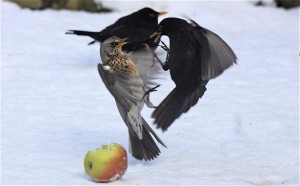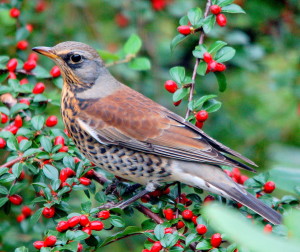By coincidence, my last couple of posts have been about Scandinavia, snow and ice, and ovicaprids. I’m not going to manage to shake free of all of those in this post either …
We woke this morning to a terrific hard frost. The countryside is white; the trees are white; it is gorgeous. It’s not quite so gorgeous inside our bedroom, where there was ice on the inside of the windows—one of the joys of living in a 300 year old cottage with all its draughts and dampness and ill-fitting doors and windows.
We call one of the gardens next to ours ‘the secret garden’. Not so much because it is hidden, but because no-one uses it. The cottage to which it belongs is rented, and none of the tenants in the last few years has shown any interest in it. Contract gardeners come and cut the grass about four times a year, and that’s it. We can see into the garden from our bedroom dormer window. There is an alder tree which has grown from a small sapling when we arrived in 1992 to a large, two-trunked tree; there is an old ruined cottage or barn or outbuilding, the stone walls of which survive to about a metre or so high and are gradually being covered by brambles; and there is a venerable old apple tree. The apple tree always fruits prodigiously, and because no-one uses the garden, the apples stay where they fall. They provide welcome food for wildlife in the winter months.
This morning the apples were providing a frosty feast for about nine or ten blackbirds (Turdus merula), a grey squirrel (Sciurus carolinensis), and a single fieldfare (Turdus pilaris). Fieldfare are a palaearctic species, living in more northerly latitudes in the summer and heading south in the winter—our fieldfare come from Scandinavia. Normally they travel in flocks, so it is always surprising to see a lone one. This one was vigorously defending its food, spending more time chasing all the blackbirds away than it was eating. Watching them, I could almost hear the Benny Hill Show theme tune in my head as the fieldfare scooted round and round the apple tree in hot pursuit of a blackbird.

Play nicely, children. (This is a small fieldfare as an adult fieldfare is quite a bit larger than an adult blackbird). Photo by Dave Jackson.
I would love to have seen this many!
Update 4 January 2015: A week on and the fieldfare is still with us. He sits in one of the higher beech trees that surrounds the secret garden, and swoops down to chase off larger interlopers who are getting too close to his precious stash of slowly-rotting apples. He tolerates the smaller birds such as chaffinches (Fringilla coelebs) and dunnocks (Prunella modularis) and blackcaps (Sylvia atricapilla), but is aggressive in his pursuit of the blackbirds. Even larger birds like jackdaws (Corvus monedula) get the ‘get orf moi laaaand’ treatment from him (or should that be written in a Scandinavian rather than a West Country accent?)
Update 29 November 2016: The fieldfare stayed for about a month, leaving the day our neighbours on the other side of the secret garden started having some very noisy chainsaw work done on their trees. We didn’t see him in winter 2015, but this morning we woke to a hard frost and a lone fieldfare guarding the apple tree in the secret garden. Is it the same bird? I’d like to think so ….
